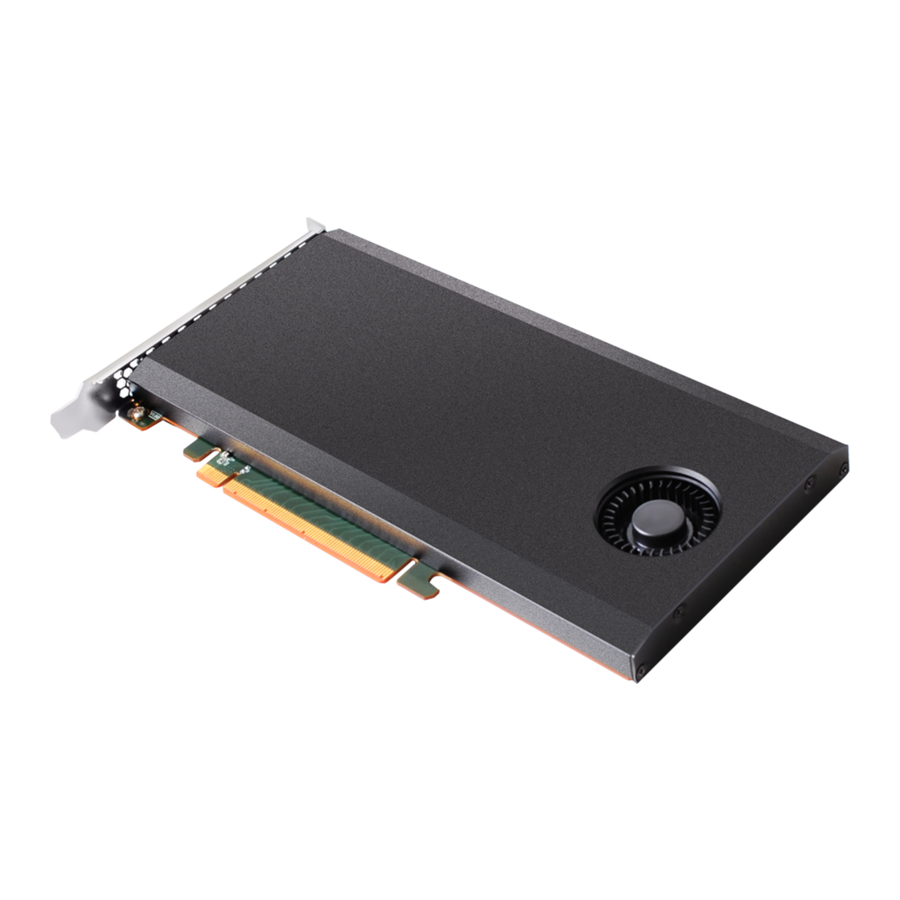
HighPoint SSD7103 Installation Manual
Nvme raid controller
Hide thumbs
Also See for SSD7103:
- Installation manual (15 pages) ,
- Quick installation manual (9 pages) ,
- Installation manual (12 pages)
Summary of Contents for HighPoint SSD7103
- Page 1 SSD7103 Linux CentOS7.6 Installation Guide HighPoint NVMe RAID Controller SSD7103 Linux CentOS7.6 Installation Guide Version 1.00 Copyright © 2019 HighPoint Technologies, Inc. All rights reserved. 1/11...
-
Page 2: Step 1 Prepare Your Hardware For Installation
If you have other SCSI adapters installed, you must make sure SSD7103 only support UEFI boot . the SSD7103 UEFI will be loaded firstly. If not, try to move it to another PCI slot. Otherwise you may be unable to boot up your system. - Page 3 SSD7103 Linux CentOS7.6 Installation Guide b. And "Advanced->PCIe/PCI/PnP Configuration->CPU Slot PCI-E OPROM" to "EFI". Suppose HighPoint NVMe is connected to motherboard CPU1 Slot 1 PCI-E X16,then you should set "CPU1 Slot 1 PCI-E X16 OPROM" to "EFI"; Disable "Secure Boot", set "Attempt Secure Boot" to "Disabled".
- Page 4 Set "OS Type" to "Other OS". Step 3 Flash UEFI Rom to HighPoint NVMe Unzip HighPoint NVMe UEFI package to root dir (/) of a USB flash driver, and insert the USB flash drive to the motherboard; b. Booting from the UEFI USB flash and enter the UEFI environment ;...
-
Page 5: Step 4 Create Array
SSD7103 Linux CentOS7.6 Installation Guide Step 4 Create Array a. Attach four NVMe SSD to HighPoint NVMe RAID Controller ; Note Make sure your USB flash partition format is NTFS or FAT32. b. Boot, in the presence of the motherboard Log screen, there will be NVMe SSD information:... -
Page 6: Step 5 Install Os
SSD7103 Linux CentOS7.6 Installation Guide e. Command “ArrayCreate.efi” to enter the Utility: f. Command “create RAID0 ”. Create RAID0 array with all disks and with maximum capacity. g. Command “exit”; h. For more command usages, refer to Appendix A. Step 5 Install OS Install CentOS7.6... - Page 7 SSD7103 Linux CentOS7.6 Installation Guide Insert the USB diskette, create a MS-DOS filesystem and extract the archive file to the USB diskette. Linux: # mkdir /mnt/hptdrv # mount /dev/sda1 /mnt/hptdrv # tar HighPoint_NVMe_CentOS_7u6_x86_64_v1.1.0_19_06_12.tar.gz /mnt/hptdrv # umount /dev/sda1 a. Install driver from USB diskette for RHEL/CentOS Linux 7.6 Put the CentOS install DVD in your CD-ROM and then reboot your system.
- Page 8 SSD7103 Linux CentOS7.6 Installation Guide When following messages show up, type the line number that line with the LABEL of USB flash drive. In this example, type 1 and press Enter Choose driver disk ISO file, In this example, type 1 and press Enter Select drivers to install [ ] /media/DD-2/rpms/x86_64/kmod-redhat-hptnvme-v1.1.0-19_06_12_el7.6.x86_64.rpm,...
- Page 9 12) After successful reboot, if you want to update the kernel, you need to download and install the Linux open source driver of SSD7103 on the official website before updating the kernel. Step1:install Linux open source driver...
- Page 10 SSD7103 Linux CentOS7.6 Installation Guide Step2:update kernel:#yum update Step3:Select the system entry after the update Support command: help/info/quit/exit/create/delete. Create Command Syntax Create Array Type (RAID0/RAID1/RAID10) Member Disk list (1/1,1/2|*)Capacity(100|*) Examples <<< create RAID0 <<< create RAID0 * <<< create RAID0 * * Create RAID0 array with all disks and with maximum capacity.
-
Page 11: Delete Command
SSD7103 Linux CentOS7.6 Installation Guide Delete Command Syntax delete {array ID} Examples <<< delete 1 Delete the first array from Logical device list. <<< delete 2 Delete the second array from Logical device list. Info Command Syntax info Display physical device list and logical list.
















